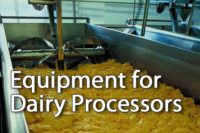Meet the Panel
- Patrik Denoth, CEO, Aseptomag, Rockford, Ill.
- Doug Harper, Director- Branded Products & Distribution, Tetra Pak, Vernon Hills, Ill.
- Jack Jordan, President, Südmo North America, Rockford, Ill.
- Jim Larsen, Business Development Manager – Valves, Alfa Laval, Kenosha, Wis.
- Jim LeClair, Global Product Manager – PD Pumps, Americas Product Management, SPX Flow Technology, Delavan, Wis.
- Dave Medlar, President, GEA Tuchenhagen North America, Portland, Maine
- Frank S. Panico, President, Alloy Cast Products, Kenilworth, N.J.
- Sam Raimond, Applications Engineering Supervisor, Fristam Pumps USA, Middleton, Wis.
- Chris Sinutko, Technical Product Manager – Valves, SPX Flow Technology, Delavan, Wis.
Pumps and valves are the hearts and lungs of a dairy processing plant. Pumps move ingredients from vats to fillers. Valves direct liquids to the proper line and allow for simultaneous production and cleaning.
Dairy processors need to be efficient, so they want to capture every bit of ice cream mix, cheese curd, white mass or fruit slurry in a line. Pumps make that happen. Water for processing and cleaning costs money. It is less expensive and a more sustainable practice to use less water. A well-designed clean-in-place (CIP) system reduces the demand for water and chemicals and the costs associated with treatment. Dairy Foods convened a virtual roundtable composed of executives from companies that manufacture pumps and valves. Following is an edited transcript.
Dairy Foods: Processors want to produce dairy foods with minimal waste. They want to get the most from milk, ice cream mix, cheese curd, etc. How can processors use pumps and valves to control costs?
Patrik Denoth, Aseptomag: One of our engineering pillars is never build a product that has one more spare part or wear item than absolutely necessary. Keeping spare-parts requirements to a minimum helps guarantee a low Total Cost of Ownership for the end-user. Another trend is the move to prevent lost production time during required CIP cycles. New mix-proof valve options allow processors to keep production running in one product line while cleaning another line via CIP. The mix-proof valves prevent any unwanted mixture of cleaning solutions and the product still in production. All this serves to save processors money and keep production going round the clock.
Dave Medlar, GEA Tuchenhagen: Product recovery systems, also called “pigging” systems, are an excellent way of using air or water to push product out of a system after production runs. Some systems can have product recovery rates of up to 99%. This system is also fully cleanable and automated, never requiring the “pig” to be manually removed from the pipe work in order to be cleaned.
Jack Jordan, Südmo: Our valve systems minimize product losses and are designed to separate high solid waste from lower solids. This is crucial because it gives processors the flexibility they need for aerobic and anaerobic membrane bioreactors to treat to both waste streams in order to maximize water reuse and possibly produce methane that reduces the energy costs of the processor. In addition, our product recovery systems are particularly effective on viscous products such as ice cream and yogurt with a 99% product stream recovery.







